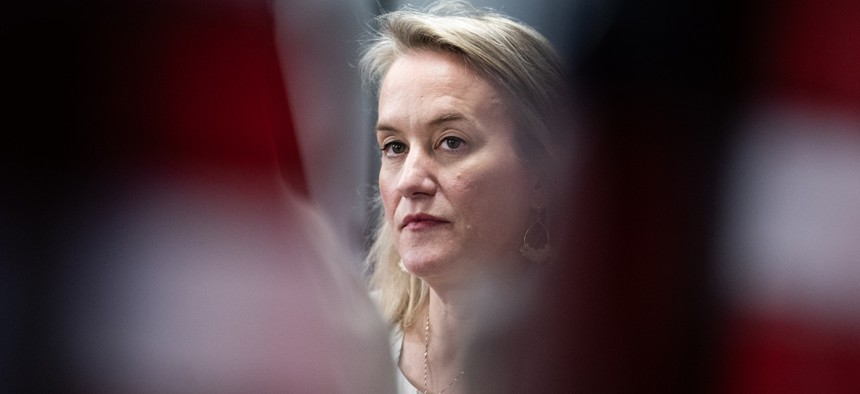
Rep. Nikki Budzinski,, D-Ill., attends a news conference with members of the New Democrat Coalition Chair on Thursday, March 13, 2025. Budzinski told Nextgov/FCW she worries staff cuts at the VA will have a negative impact on its ongoing EHR rollout. Tom Williams / CQ-Roll Call, Inc / Getty Images
VA tech panel’s top Democrat worries layoffs will harm EHR rollout
Rep. Nikki Budzinski, D-Ill., is concerned that staffing vacancies, coupled with the department’s reduction in force plans, will put “more pressure onto the VA to execute on an expedited calendar for implementation” of its new EHR system.
A top Democrat on the House committee overseeing the Department of Veterans Affairs is concerned that further workforce reductions and spending cuts across the agency will hamper VA’s push to restart deployments of its new Oracle Health electronic health record system.
In an interview with Nextgov/FCW, Rep. Nikki Budzinski, D-Ill. — the ranking member of the House Veterans’ Affairs Technology Modernization Subcommittee — said successfully rolling out the EHR system remains “the most important goal” of the panel, even as she noted that “there have been a number of issues” with the project.
VA initially signed a $10 billion contract — which was later revised to over $16 billion — with Cerner in May 2018 to modernize its legacy health record system and make it interoperable with the Pentagon’s new health record, which was also provided by Cerner. Oracle later acquired Cerner in 2022.
VA, however, has deployed the EHR software at just six of its 170 medical centers since 2020, largely as a result of patient safety concerns, technical issues and usability challenges associated with the new system. VA paused most deployments of the EHR system in April 2023 as part of a “reset” to address problems at the facilities where the software had been deployed.
The department announced in December that it was moving out of the operational pause and planned to roll out the new EHR software at a total of four medical sites in mid-2026. VA Secretary Doug Collins — who said during his confirmation hearing that “there's no reason in the world we cannot get this [modernization project] done” — subsequently announced in March that VA planned to deploy the software at nine additional medical facilities next year, bringing the total to 13 sites.
But the resumption of the EHR modernization project also comes as VA looks to cancel contracts deemed unnecessary and shed as many as 83,000 employees under governmentwide cost-cutting efforts. Collins and other VA officials have stressed that the cuts would not affect mission-critical operations, such as clinicians and other healthcare professionals. VA has also exempted 300,000 jobs from President Donald Trump’s federal hiring freeze.
Some of the canceled contracts, however, have been for services tied to the EHR project. And some employees in VA’s EHR modernization office have also been affected by layoffs, or have chosen to accept the department’s deferred resignation offer.
Budzinski noted that VA has already been operating with staffing deficiencies, with the department telling Congress in a late 2024 report that it had approximately 40,000 open positions nationwide.
“So if we're already — and we were from the last administration — operating with vacancies … we're making this problem even worse, and we're compounding it by adding more pressure onto the VA to execute on an expedited calendar for implementation,” she said. “That is going to be very challenging to achieve.”
During a full House Veterans’ Affairs Committee hearing last month, Budzinski also cautioned that staffing and budget cuts to VA’s Office of Information and Technology would likely disrupt the agency’s IT upgrade efforts.
She reiterated those concerns during her interview with Nextgov/FCW and pointed out that modernization efforts across VA are not just limited to the deployment of the new EHR system.
“Oftentimes you see where cuts are made first are in places like IT departments, when actually those are the places where we need more investment,” Budzinski said, arguing that technology modernization efforts will lead to departmentwide improvements but that "if we don't invest in that process, we're going to come up short.”
Budzinski alluded to the focus of the Elon Musk-led Department of Government Efficiency and said ensuring that retired servicemembers’ health records can easily transition with them from active duty to civilian life will improve the overall quality of care that they receive.
“Modernizing the VA and helping to do that through technology is really, I think, the best example of where we will be able to find meaningful efficiencies,” she said.
Concerns about the impact of staff layoffs and spending cuts on VA’s research workforce have also drawn considerable attention, particularly since over half of the agency’s 6,500 researchers are term-limited employees who have not been exempted from proposed cuts or the Trump administration’s federal hiring freeze.
Budzinski was one of 10 Democrat members of the House Veterans’ Affairs Committee to sign an April 1 letter to Collins that called for VA to provide lawmakers with additional information about how its proposed layoffs would affect department research personnel and interfere with ongoing studies and projects.
“I think a lot of people don't fully appreciate how VA has been really one of the most successful incubators of cutting edge research that has then gone on and benefited those of us that didn't serve,” she said during the interview. “That research and technology has benefited all of us — veteran or non-veteran — and so when you make these kinds of cuts, it's going to have a very wide, broad implication for healthcare in general.”







